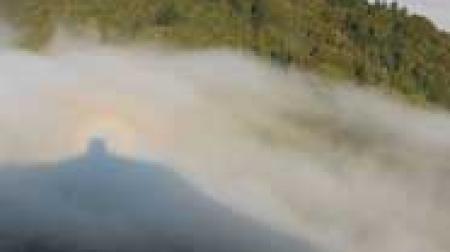Information Gaps
Overview
In addition to helping share what is known about the health of Mt. Tam, this assessment process revealed critical data gaps for a number of important health indicators. One Tam agencies are planning to develop inventory and monitoring plans for many of these in the near future. Click on one of the links below to jump to a particular topic.
- Insects
- California Giant Salamander
- Bats
- Small Mammals
- Seeps, Springs & Wet Meadows
- Riparian Forests & Woodlands
- Hardwood Forests & Woodlands
- Douglas-fir Forests
- Lichens
- Soils
- Hydrologic Functions
Due to their unparalleled diversity, small size, and often cryptic habits, there are few complete insect surveys for most ecosystems, including those found on Mt. Tam. Outside of some work on butterflies, the mountain’s invertebrates have not been well studied.
Reviewing and consolidating species records from existing collections will be a crucial step in developing invertebrate monitoring programs. Teaming up with local entomologists will help set the focus for these inventories, address data gaps, and interpret the results in the context of larger-scale patterns of richness and population fluctuations.
All-taxa “bioblitzes” involving experts and interested community members could also produce valuable information on the insect fauna of selected habitats over a number of years. Taxa-specific inventories might include dragonflies and damselflies (Odonata), ground beetles (Carabidae), butterflies and moths (Lepidoptera), ants (Formicidae), and bees (Apoidea).
Although not federally listed, this species is a Special Status animal and has a state Natureserve rank of S2/S3 (imperiled/vulnerable) and an ICUN status of near threatened. They are excellent indicators of stream health due to their relatively long lives and stable population sizes.
California giant salamanders live in some of Mt. Tam’s streams; however, our current knowledge of giant salamanders is limited to a larval inventory of the species in Redwood Creek in Muir Woods and Mount Tamalpais State Park, limited stream surveys by USGS in the region on federal lands, and incidental observations during fish surveys.
The primary goal of California giant salamander monitoring would be to establish a baseline of presence/not found status for all of the headwater streams in the One Tam area of focus. California giant salamanders are easily distinguished from other salamanders and newts, and would also be suitable for a community science inventory and monitoring program.
Mt. Tam supports a diverse bat community that provides important ecosystem services such as insect control. Bats are good ecological indicators because they are sensitive to climate change, habitat loss, pesticides, disease, and disturbance at breeding colonies.
Our current knowledge of bats on Mt. Tam is limited to inventory studies of bats at Muir Woods and MMWD structures, as well as very limited monitoring and research. Completion of a comprehensive bat inventory is a necessary first step in developing a monitoring program that can inform meaningful protection for at least 12–14 bat species believed to occur on Mt. Tam.
The primary goal of bat monitoring would be to establish a baseline of bat species diversity in priority habitats (e.g., redwood and Douglas-fir forest, oak woodlands, riparian areas, and lakes). Also, identifying locations of key maternity colonies would allow these sites to be monitored, protected, and investigated for white-nose syndrome.
Small mammals are sensitive to habitat change, are an important food resource for predatory species, and can impact vegetation by consuming and dispersing seeds.
Mt. Tam supports a diverse small mammal community, but they have not been well studied. Inventories of the Golden Gate National Recreation Area (Semenoff-Irving & Howell, 2005), Muir Woods National Monument (Howell et al. 1998), and Point Reyes National Seashore (Fellers & Pratt, 2002) have been completed, but not updated. Additional work on Mt. Tam includes an inventory of small mammals at Muir Beach (Takekawa et al., 2003) and Sudden Oak Death research on deer mice and woodrats (Swei et al., 2011). The Marin Wildlife Picture Index Project is providing information on the terrestrial mammal community larger than 1 kg., and more information on the state of small mammals on Mt. Tam would complement that project.
Goals of small mammal monitoring would be to inventory small mammals in priority habitat types, including updating previous monitoring work. Particular attention would be paid to cataloging the species that are currently present, in order to identify whether species are disappearing from, or moving in to, the Mt. Tam area. Particular attention should be paid to habitat types that are rapidly changing.
Seeps, springs, and wet meadows are characterized by fresh groundwater discharge that rises to form distinctive wetland features. These areas support (often unique) ecosystems (Howard & Merrifield, 2010) and certain rare plants. These nutrient-rich environments provide vital food and habitat for many insects, amphibians, reptiles, birds, and mammals, and can be used as indicators of biological integrity and diversity, natural processes, climate change vulnerability, natural disturbance regime, and habitat quality.
Our current knowledge of the locations, discharge rates and size of wetland features is limited to few inventory studies (to primarily on NPS lands) and very limited monitoring. Developing a mountain-wide survey protocol and associated monitoring program that helps us understand hydrology and species composition will improve our understanding of how these landscape features are changing in response to climate change and other stressors.
The proposed Potrero Meadow One Tam Pilot Project would re-align existing trails so that they circumnavigate the diverse wetland habitat. It would also identify and implement a strategy to control and remove invasive non-native perennial grasses and stimulate revegetation with wetland species, allowing for habitat revitalization.
Riparian areas comprise less than 1% of the land in the western United States (Natural Resources Conservation Service, 1996); however, native riparian plant communities make up some of the most productive wildlife habitats in North America. They are critically important to the life cycle of endangered salmonid species (Federal Interagency Stream Restoration Working Group, 1998), and the linear nature of riparian ecosystems provides distinct corridors that are important as migration and dispersal routes. These systems are also responsible for the regulation of critical ecosystem functions such as nutrient cycling, energy transfer, and water purification in adjacent aquatic environments.
Mt Tam’s riparian forest and woodland species are being impacted by many stressors including groundwater depletion, climate change, and non-native invasive species. It would be important to monitor the changes and impacts to these ecosystems as they react and respond to these stressors.
Our current knowledge of both the integrity and connectivity of Mt Tam’s riparian habitats is limited to past monitoring efforts focused on specific restoration projects or weed detection surveys. Developing a mountain-wide assessment and associated monitoring program will improve our understanding of the health of these communities, and how these landscape features are changing in response to climate change and other stressors.
Hardwood forests and woodlands are the most extensive set of tree-dominated vegetation types within the One Tam area of focus, covering 7,110 acres or 20% of the One Tam open space. Therefore, the extent, integrity, and health of these communities would be an important indicator of the health of Mt. Tam.
These forests and woodlands include areas dominated by tree species that provide important food and habitat for a wide range of wildlife, including: California bay (Umbellularia californica), madrone (Arbutus menziesii), tanoak (Notholithocarpus densiflorus), canyon live oak (Quercus chrysolepis), chinquapin (Chrysolepis chrysophylla), buckeye (Aesculus californica), and bigleaf maple (Acer macrophyllum).
The mountain's hardwood forests and woodlands are being impacted by many stressors including pathogens, climate change, altered fire regimes, non-native invasive species, and others. Future monitoring could assess the impacts of stressors on the trees and their associated ecosystems, vegetation and associated changes driven by those stressors, stand demographic structure and trends, wildlife use and biodiversity, and differences in stand composition and health in both burned and unburned areas.
Forests where Douglas-fir (Pseudotsuga menziesii) is the dominant canopy tree cover are found primarily in the moister microclimates in the One Tam area of focus north of Kent Lake, along portions of the Bolinas Ridge western slope, and around the mountain’s northern, western, and southern slopes.
Douglas-fir and the forests it dominates are important habitats for species such as the Northern Spotted Owl (Strix occidentalis caurina) (Cary et al., 1990; Glenn et al., 2004). Seeds of this tree are an important part of the diet of many mammals including mice, voles, shrews, chipmunks, and squirrels (Gashwiler, 1970; Arno, 2007) as well as many birds such as Dark-eyed Juncos (Junco hyemalis) and White-crowned Sparrows (Zonotrichia leucophrys) (Black, 1969; Arno, 2007).
It is believed that Douglas-fir has been steadily expanding its range and dominance since the institution of effective fire suppression and the cessation of widespread logging. This recolonization, or spread, is considered an invasion into other vegetation types and management action is often directed at removing this species.
Additional monitoring and data collection for Douglas-fir forests would help reveal the impacts of stressors to this species and the forests it dominates, stand demographic structure, wildlife use and biodiversity, and differences in stand composition and health in both burned and unburned areas.
Mt. Tam hosts a remarkable diversity of lichens for the same reasons the area supports so many different types of plants—its diverse array of habitats and microclimates. Lichens provide a number of ecosystem services including nesting material, food, habitat, soil development and stabilization, carbon fixation, and nutrient cycling.
Lichens are known for their sensitivity to air pollution and climate change, and are one of the first groups of organisms to respond to shifts in environmental conditions. Therefore, detecting a change in the lichen community can be a sign of impacts on ecosystem function and integrity.
A lichen monitoring program would follow nationally standardized protocols and use regionally specific air quality and climate gradient models developed by the US Department of Agriculture (USDA, 2011). Four to five plots could be tied into current and future vegetation community monitoring plots and would be resampled once every five years.
Soil is increasingly recognized as a critical component of ecosystem health with remarkable levels of biodiversity (Bardgett & van der Putten, 2014). Soil biodiversity is also increasingly recognized as providing benefits to human health because it can suppress disease-causing soil organisms and provide clean air, water, and food (Wall et al., 2015).
Despite so much recent attention given to the importance of soils, little information exists on soil biodiversity and function in general, and none on Mt. Tam specifically. Yet, Mt. Tam may host an impressive amount of soil biodiversity given its array of vegetation communities, soil types, diverse topography, and microclimates.
Developing a survey protocol and collecting baseline data will help provide a more complete picture of biological diversity on Mt. Tam and establish a benchmark against which future resampling efforts can be used to assess the mountain’s health.
Hydrologic functions are central to the mountain’s health, and include indicators such as the quantity and quality of stream flows available for fish and other aquatic organisms, soil moisture to support plant establishment and growth, the delivery of sediment from watersheds into streams, and much more. These functions are highly vulnerable to a range of human impacts, including global climate change, the construction and operation of dams and other infrastructure, fire protection activities, and vegetation management.
Despite (or because of) their fundamental importance to ecosystem health and their vulnerability to anthropogenic change, hydrologic functions can be challenging to monitor, analyze, and interpret. These challenges are magnified by the fact that the mountain’s four public land managers each have distinct missions, management goals, institutional and administrative structures, and financial and staffing resources.
Existing monitoring of hydrologic functions on Mt. Tam is dominated by metrics measured to meet regulatory requirements. The absence of a landscape-scale, management-driven approach makes it difficult for land managers to understand and address Mt. Tam’s watershed health. The patchwork nature of data describing existing conditions will make it even harder for land managers to assess the future impacts of climate change, including likely shifts in fundamental hydrologic drivers such as precipitation and temperature.
Future monitoring should address the following elements across the mountain:
-
Stream peak and low flows
-
Watershed runoff vs. infiltration
-
Road density and conditions
-
Floodplain connectivity
References Cited:
Arno, S. (2007). Northwest Trees. Seattle, WA: Mountaineers Books.
Bardgett, R. D. & van der Putten, W. H. (2014). Belowground biodiversity and ecosystem functioning. Nature, 515, 505–511.
Black, H. C. (1969). Fate of sown or naturally seeded coniferous seeds. Wildlife and reforestation in the Pacific Northwest: Proceedings of a Symposium, 42-51.
Carey, A. B., Reid, J. A., & Horton, S. P. (1990). Spotted owl home range and habitat use in southern Oregon Coast Ranges. Wildlife Management, 54(1), 11-17.
Federal Interagency Stream Restoration Working Group (FISRWG) (10/1998). Stream Corridor Restoration: Principles, Processes, and Practices. By the Federal Interagency Stream Restoration Working Group (15 Federal agencies of the US government). GPO Item No. 0120-A; SuDocs No. A 57.6/2:EN 3/PT.653.
Fellers, G.M. & Pratt, D. (2002). Terrestrial vertebrate inventory, Point Reyes National Seashore, 1998-2001. National Park Service Report.
Gashwiler, J. S. (1970). Further study of conifer seed survival in a western Oregon clearcut. Ecology, 51(5), 849-854.
Glenn, E. M., Hansen, M. C., & Anthony, R. G. (2004). Spotted owl home-range and habitat use in young forests of western Oregon. Journal of Wildlife Management, 68(1), 33-50.
Howard J.,& Merrifield, M. (2010). Mapping Groundwater Dependent Ecosystems in California. PLoS ONE. 2010, 5(6).
Howell, J.A., Ettlinger, E., Semenoff-Irving, M., & Stout, S. (1998). Muir Woods inventory of sensitive species in old-growth forest: Mammalian inventory summer 1997, winter 1998. U. S. Geological Survey report to the Golden Gate National Recreation Area.
Natural Resource Conservation Service (NRCS). (1996). Riparian Areas Environmental Uniqueness, Functions, and Values. RCA Issue Brief #11. Retrieved from http://www.nrcs.usda.gov/wps/portal/nrcs/detail/national/technical/?cid=nrcs143_014199.
Semenoff-Irving, M., & Howell, J.A. (2005). Pilot inventory of mammals, reptiles, and amphibians, Golden Gate National Recreation Area, California, 1990-1997. U. S. Geological Survey, Open-File Report 2005-1381.
Swei, A., Ostfeld, R.S., Lane, R.S., & Briggs, C.J. (2011). Effects of an invasive forest pathogen on abundance of ticks and their vertebrate hosts in a California Lyme disease focus. Oecologia, 166(1), 91–100.
Takekawa J.Y., Bias, M.A., Woo, I., Demers, S. A., & Boydston, E. E. (2003). Small mammal survey at Big Lagoon, Muir Beach, Marin County, CA (Unpublished progress report). Vallejo, CA: U.S. Geological Survey.
U.S. Department of Agriculture, Forest Service. (2011). Field instructions for the annual inventory of Washington, Oregon, California, and Alaska: supplement for phase 3 (FHM) indicators, Section 21. Lichen Communities. Version 5.1. Portland, OR: Pacific Northwest Research Station.
Wall, D.H., Nielsen, U.N. & Six, J. (2015). Soil biodiversity and human health. Nature, 528, 69-76.




